ADCAIJ: Advances in Distributed Computing and Artificial Intelligence Journal
Regular Issue, Vol. 12 N. 1 (2023), e31607
eISSN: 2255-2863
DOI: https://doi.org/10.14201/adcaij.31607
Appointment Booking and Drug Inventory System in Healthcare Services Using Blockchain Technology
M. Sumathia, Inti Dhirajb, Dhavala Sai Mahitab and S. P. Rajac
aAssistant Professor, School of Computing, SASTRA Deemed to be University, Thanjavur, Tamil Nadu, India.
bUG Student, School of Computing, SASTRA Deemed to be University, Thanjavur, Tamil Nadu, India
cAssociate Professor, School of Computer Science and Engineering, Vellore Institute of Technology, Vellore, Tamil Nadu, India.
sumathi@it.sastra.edu, 124157027@sastra.ac.in, 124157015@sastra.ac.in, avemariaraja@gmail.com
ABSTRACT
Blockchain technology has the potential to revolutionize the healthcare industry by improving data security, reducing administrative inefficiencies, and enabling the seamless sharing of medical information. In the healthcare sector, blockchain can be applied to a wide range of use cases, such as medical record-keeping, clinical trials, drug traceability, and telemedicine. By using a secure, decentralized system, healthcare organizations can ensure that sensitive patient data is kept confidential and can be easily accessed by authorized parties. Additionally, the use of smart contracts can contribute to reducing the risk of errors and saving time and resources. In the proposed work, a decentralized application integrates healthcare services with blockchain technology to ensure transparency and security and prevent tampering with electronic medical records. The three main functionalities implemented in this work are to provide a transparent appointment booking system where patients can view the real-time availability status of the doctors and book an appointment with the doctor of their choice, and to store and retrieve data in an efficient and secure manner. To maintain a transparent and tamper-resistant medical inventory to prevent the unauthorized sale of medicines and drugs and also verify the availability of the drug. This helps the patients get the drugs in the quickest manner possible. Compared to existing centralized storage techniques, the proposed decentralized storage technique provides higher data availability, the fastest response time, and immutable storage of existing data. Experimental results show that, compared to existing work, the proposed work provided better results in throughput and latency. The communication cost of the proposed technique is 7% lesser than the existing Telecare Medicine Information system.
KEYWORDS
Blockchain; Ethereum; Smart contracts; Healthcare; Appointment booking; drug inventory.
1. Introduction
Blockchain (BC) technology provides a secure way of storing data; an example of this is the Bitcoin BC, on which Bitcoin digital currency is used to perform transactions. Hence, the technology can be extended to use in prominent areas such as finance and banking, education, supply chain management, e-voting, electronic copyright, real estate, healthcare etc. BC provides a tampered-proof and evident storage system. Due to this property, the tracing of transactions is easiest for users. Thus, BC is used in most of the applications. The reason behind for choosing the healthcare (HC) application here is to improve the healthcare services in different aspects (Baysal et al., 2023). In the HC application, BC is used for dental data management, medical data management, health insurance data management, a virtual doctor platform, pharmaceuticals data management etc. These HC management systems involve doctors, patients, HC organizations, clinicians and pharmacy members. In the existing centralized storage system, the healthcare professionals work and manage the data independently. To get the details of a specific patient from all of them is a complicated and time-consuming task. Hence, a BC-based decentralized storage technique is required to provide timely service to patients (Sumathi et al., 2022).
The existing healthcare system is managed in a centralized manner. The security and privacy of patient data are fully dependent on the data managers. This led to security and privacy issues such as identity theft, masquerade, man-in-the-middle attacks, and phishing attacks. A single point of failure is also possible in the centralized storage system. Thus, the decentralized BC-based patient information storage is developed in the proposed work (Sharma et al., 2023). To resolve these issues, numerous BC-based solutions were proposed to addresses the concerns regarding the leak of user’s personal information to a third-party. There are two components used for secure storage, such as BC storage and web portal for the users to interact with. Patients are unaware of the BC storage system. For patient understanding and communication, a web page design is required as part of the current development. Through a web-based user interface, users are able to interact with the BC and perform various actions (Tidke et al., 2022). Conventionally, for appointment booking, patients went to hospitals and booked appointments to meet the doctors or made a call to hospitals and booked the appointment. Patients are unable to verify the booking time, date, and doctor’s availability. This leads to time and money wastage for patients and leads to critical situations for their health. To avoid these issues, patient-centric decentralized appointment booking is required in the present scenario. Likewise, in a pharmacy system, patients are unaware of the availability of the drug, the cost of the drug, and expiration date of the drug. For the HC industry, everything is important to save the patient’s life. Hence, drug management also needs decentralized storage system (Ukanah et al., 2020). Based on these requirements, in a proposed work, the user-centric appointment booking, and transparent drug inventory system are developed. The merits of the proposed work are listed as follows:
• It serves as a single roof for patients, hospital administrators and pharmacists to perform their day-to-day actions without any hindrance, while also ensuring that all medical data is secure.
• Proper authentication of users is performed, and accounts are strictly provided only to genuine users in an offline manner upon verification of their identity. This ensures that only authorized people are allowed to be stakeholders on the BC.
• The appointment booking system provided to patients is simple and user-friendly, where one can not only book appointments but also view the appointment details for the day. The system is built in a way to handle the day-to-day changes in the number of doctors and slots dynamically.
• The drug inventory facility is built for the pharmacists to keep a log of the outgoing supply of medicines. Every sale must be logged onto the drug inventory BC by the pharmacist. This feature is useful to check if the medicines are being sold legitimately by comparing the incoming and outgoing supplies.
• The drug traceability feature is used to provide the patients with detailed information on every medicine. Upon entering the RFID of the medicine, the user can trace its manufacturing details, expiration date, lot number, etc. This establishes a sense of transparency, thereby building trust among patients. Pharmacists can view traces of all the drugs.
The remaining part of this article is organized as follows: In Section 2, the existing works related to BC-based HC systems are analysed in detail with their merits and demerits. In Section 3, the proposed work is explained with the necessary architecture and algorithms. In Section 4, the experimental results of the proposed work are compared with the results of existing techniques, and in Section 5, the security and privacy aspects of the proposed work are discussed. Finally, in Section 6, the proposed work is concluded with future work.
2. Related Works
The works related to BC in HC are analysed in depth in this section, along with their merits and limitations.
Hovorushchenko T. et al. (2023) discussed the methods of HC data management based on BC technologies. During COVID-19, the HC industry faced lots of challenges, such as providing treatment to patients, especially elderly people, and distributing drug to diabetic patients, etc. Hence, a supply-chain has been developed to provide vaccines, tests, and treatments to patients. In a BC network, every block is dependent on the previous block’s hash value (HV). The changes in one block are reflected in the other block as well. Hence, tracking blocks is an easier process than in a centralized storage tracking system. Belmonte et al. (2023) analysed the applications of BC in the COVID-19 era. BC helps to detect the infection sources through the processing of institutional, organizational, and individual data. Similarly, BC helps to track the supply-chain by calculating drug inventories and analysing the balance of drug information between customers and suppliers, etc. Additionally, BC provides immutable, transparent, and traceable data to end users. Hence, analysing the data provides accurate data between the analysers. Niveditha et al. (2021) discussed BC-based medical data sharing between patients and hospitals. When a patient visits a doctor, the patient needs to register in the hospital, and the hospital assigns doctors to patients. Once the treatment is complete, the healthcare professional verifies the medical documents and stores the medical data in the BC. In the future, any doctor or patient will be able to access the medical data. This storage technique helps to store data in a decentralized medical data storage. However, appointment booking was done by the hospital, not by a user.
Surameery et al. (2023) proposed the BC as a foundation to support HC systems. The major issue of the HC sector is maintaining the patient record. Because accessing the entire HC record required additional waiting time and expenses and limited the patient’s ownership of their own record. Likewise, the patient records are accessible only by the existing doctors. If any new doctor tries to access the record, it is impossible. Hence, BC-based record maintenance is required to prevent the duplicate record storage and allow patients and new doctors to access the records without any issues. In this work, data management and access are explained clearly, but appointment booking and drug analysis are not discussed. Additionally, in BC technology, data traceability is the easiest task. Wolfond (2017) improved delivery systems in public and private sectors using BC technology. The conventional appointment booking in hospitals is done by phone calls, later the history of appointment is gone from the patient’s side. The patients are unable to get the proof of appointment later. So, BC-based appointment booking is required for tracking in the future. Likewise, the patient reports that access is difficult for the patient. If the block is stored in a BC, patients are able to access the data without any consequences. Thus, the BC technique is required in the current system.
Akshita et al. (2021) discussed the BC-based COVID vaccination booking and management system. In a pandemic situation, to vaccinating the public is an essential and foremost requirement. The vaccination appointment and vaccination details were stored in a BC ledger and verified by the authorities, healthcare professionals, and public in an easiest manner possible. Due to immutable storage property of BC, verifying the vaccination details for a particular person is an easy task. Tang et al. (2021) used BC and searchable encryption to share the HC records. The integrity of the HC record is confirmed using the global encryption search index. The addition, deletion, and modification of HC are made possible via forward security. The BC approach uses the sharing of a global ID between parties to secure data sharing. Other hospital doctors who know the patients can access the patient histories by using this global ID. Saidi et al. (2022) discussed the privacy-aware self-management access control system built on BC. Patients (self-grant access control) set the role-based access constraints for managing emergency cases. Utilizing smart contracts, authorization deployment and verification are made possible. Jayapriya et al. (2022) proposed the scalable BC approach using off-chain IPFS storage of HC data. The fake node attack is stopped by employing a multi- and two-factor authentication system. Before being stored in IPFS, HC records were encrypted using AES-128. HV generation uses SHA-256 while key sharing uses RSA. By using multiple layers of security, IPFS is protected from attacker access. Scalability problems are resolved by the IPFS storage representation.
2.1. Gap in Existing Work
The current appointment booking system is a closed system, and it is dependent on the hospitals. Patients are unaware of the availability of doctors. Similarly, the drug and medicine inventory is also a closed system. Healthcare organizations are unable to trace the drug sales information.
To overcome these issues, the proposed work is going to address the following functionalities:
• A transparent appointment booking system for patients: Patients can view the real-time appointment status and book an appointment with a doctor of their choice.
• To provide a transparent and tamper-resistant medical inventory: To prevent the unauthorized sale of drugs and medicines.
• To provide a system to store and retrieve patient, doctor, and pharmacy data in a secure and efficient manner.
2.2. Objective of the Proposed Work
• To develop a secured, decentralized system to ensure the confidentiality and integrity of patient data.
• To implement various HC services on the decentralized system and make them accessible to medical professionals and patients as and when required.
2.3. Scope of the Proposed Methodology
• A contract is created to contain all the transactions where appointments are booked by patients. Patients can check the status of their appointments whenever they wish to do so.
• Another contract is created to maintain transactions associated with the sale of drugs and medicines at pharmacies. It is to determine whether a medicine is in stock and available for future prescriptions.
• A web-based application is developed. It consists of three portals: For a patient, doctor, and pharmacist to store and retrieve information accordingly. Patients can keep track of information about appointments and medications with the use of a user-friendly web-based approach.
3. Proposed Work
Appointment Booking
The lists of doctors available for the day, along with their appointment slots, are visible to the patient. Once a patient tries to book an appointment, if the slot is available, the slot is booked; otherwise, an appropriate message is generated. To facilitate this feature, a smart contract (SC) is used for the deployment of BC. The details associated with each appointment are stored in the BC in the form of transactions. This ensures that the booking of appointments is done in a transparent manner. The booking details are able to be viewed by other users in the form of booking address, patient name, doctor name, slot number, date, and timestamp value. The sender address is stored in the form of HV. This HV is generated by is secured hash algorithm 256 (SHA256) to ensure the immutability of user information. The remaining information is stored in the form of plaintext. The proposed work is generated in permissioned network, so adversaries are unable to access the user information from the network. Similarly, the basic information is only stored in plaintext form, so the privacy of the patient is maintained in the proposed work. Figure 1 shows the flow of proposed system. Equation 1 shows the booking information of each patient.
Figure 1. Flow of proposed system.

Where
PID – Patient ID,
DID – Doctor ID,
Sno –Slot number
Nonce – Timestamp value
The proposed system for HV generation uses SHA256 because it is collision resistant, preimage resistant, deterministic, greater output, and Avalanche effect resistant. These characteristics aid in producing the best possible candidate blocks in a BC since they offer unparalleled dependability and security.
The nonce value helps to identify the booking information in a unique way. In this system, the patient can view the doctor’s availability and existing booking information in the fastest and most accurate manner. This helps the patients to save time. Algorithm 1 shows the SC between the patient and hospital administration for booking an appointment.
Algorithm 1. SC between patient and hospital administration
SC 1: Patient and Hospital Administration
Input: Patient, Admin, Doctor, Slot, Date
Output: Book Appointment or Reject Appointment
1. if(PID ==Registered PID) then
2. if (DID == Available DID) then
3. Enter Date and Slot
4. if(Date AND slot == Free) then
5. Book an appointment
6. Bookinginfo=Hadd (patient)+PID+DID+Sno+Date+Nonce
7. else if (Date == Free && slot != Free) then
8. Request to change the slot
9. else
10. Request to change the date and slot
11. else
12. Doctor is unavailable
13. else
14. Invalid user, register to the network and validate the authentication
Return Bookinginfo
Drug Inventory
Every drug sale is associated with the RFID of the drug, pharmacist ID, doctor ID, patient ID and the list of medicines purchased in that sale. When a pharmacist makes a sale and enters the details about the drug and identification details for maintaining the log of the sales made, a drug inventory SC was created and deployed on the BC. Every time a sale is made, the details are stored on the BC. This can be used to verify if the drugs are being sold ethically and ensure transparency. Equation 2 shows the HV of drug sale.
Algorithm 2. SC between doctor and pharmacist.
SC 1: Doctor and Pharmacists
Input: Patient, Doctor, Drug, Pharmacists, Manufacturer, MRIFD
Output: Deliver the Drug or not
1. if(MRFID ==Available_MRFID) then
2. if (Manufacturer == Available Manufacturer) then
3. Enter Quantity of Drug
4. Deliver the Drug
5. else if (entered Manufacturer != Available Manufacturer) then
6. Check the drug by doctor and recommended
7. else
8. Drug not recommended and verify the available date
Return Drug_ifno
A web application is developed for a seamless user experience and efficient operations. The backend routes are written to create and retrieve doctor, user and pharmacist details. Login pages are created for users, administrators and pharmacists. After logging in with their respective credentials, users, administrators and pharmacists can view their respective home pages. Users can view their profile and all other appointments booked. The patients can book an appointment depending on the availability of slots. Pharmacists can view their profile and all other sold and available medicines. The details associated with every successfully booked appointment or sold medicine are stored on the BC. These details are essentially the transactions that are carried out over the BC, and the transaction hash is fetched accordingly. Algorithm 2 shows the SC between doctor and pharmacists.
The technical aspects of the BC are unknown to the patients. As a result, a web page is established for the BC-based appointment scheduling and drug analysis. Everyone can verify the specifics with less technical understanding as a result of a user-friendly approach. The two distinct tasks are combined on a single webpage, as proposed in this work.
4. Experimental Results
The proposed system is implemented by using Windows 7, an AMD-Ryzen 5 processor, and 8GB RAM. On the software side, Solidity programming, Visual Studio Code IDE, and Node modules are used for implementation. The application built a tech stack called the MERN stack (Mongo DB, Express.js, React.js, and Node.js). The MERN stack is linked to the decentralized BC environment. React libraries are used to establish a connection to the BC network. An open-source BC platform, Ethereum, is used to develop the decentralized application (DApp). The development of SC is done by Solidity Language. The IPFS storage is used as a storage mechanism for DApp, where patients can store their information. Ganache is used for development and testing purposes, to perform transaction in BC and some crypto-currency is required to perform a transaction. It can also be used to deploy a local Ethereum BC. The Truffle framework makes it easy for the development of the portal and the integration of the BC into it. Mongo DB is used for user authentication in the application, and the website is developed using the JavaScript framework React.js. Table 1 shows the hardware and software requirement of the proposed work.
Table 1. Hardware and software requirements
Hardware Requirements |
Software Requirements |
||
Components |
Description |
Components |
Description |
Operating System |
Windows 7 |
Programming Language |
HTML, CSS, Javascript, Solidity, React.js |
Processer |
AMD-Ryzen 5 |
Operating system |
Windows 7 |
Memory |
8GB |
Browser |
Microsoft Edge, Chrome |
BC platform |
Etherem, Ganache, MongoDB, Truffle |
||
The experimental results of the proposed work are shown and explained in the following snapshots. Figure 2 shows the front end of the proposed system. This page consists of the patient, pharmacist and administrator login page. By using username and passwords, the existing users are able to access the data on the network. The new user needs to register on the network before accessing block information.
Figure 2. Front End dashboard of the proposed work

Figure 3 shows that the user must login to the dashboard. By using a registered mail ID, the patient can login to the booking system. It shows the account details such as the patient ID, name, and date of birth, phone number, mail ID, and account address of the patient. By using the email ID and password, the patient, doctor, and pharmacists are able to login to the system.
Figure 3. Existing user login page

Figure 4 shows the user home page after login. By using this page, the user is able to book an appointment, view existing appointments for the day, and view their account details. By viewing the existing appointment details, the patient is able to identify the specific doctor’s availability at a specific consulting time.
Figure 4. User home page

Figure 5 shows the patient registration process for a specific slot with a specific doctor. This dashboard displays the doctor’s availability for a particular slot. After successful registration, the patient can confirm their registration details. Figure 6 shows the booking confirmation details.
Figure 5. Patient appointment booking

Figure 6. Appointment booking confirmation and view of the existing booking

Figure 7 shows the drug availability information. The drug information is verified by a RFID. The medicine name, available quantity, price of the medicine, manufacturer name and expiration date. By using these details, the patients can verify the medicine details on their own.
Figure 7. Viewing medical details by RFID

Sometimes doctors prescribe medicines which are not available in the pharmacy. In that case, the pharmacists refer another manufacturer’s medicine instead of the prescribed medicine. This may cause health issues. To avoid this issue, the doctors should be informed about the availability of the medicine in the pharmacy. Manual verification is a time-consuming task. To rectify this issue, after the delivery of medicine, the available list of medicine is updated in the block. Based on that availability, the doctors are able to prescribe the medicine to patients. Figure 8 shows the availability of medicine details.
Figure 8. Viewing medical details

Based on the availability of medicine and the doctor’s prescription, the pharmacists provide the medicine to patients and enter the details in the block. Figure 9 shows the sale of medicine to patients, and Figure 10 shows the drug inventory information.
Figure 9. Selling of medicine

Figure 10. Drug inventory details

5. Performance Analysis
The performance analysis of the proposed system is compared with existing works related to communication and computation.
The communication cost (CC) consists of the time taken to receive the login message and verify the authentication of the user. The CC depends on the 160-bit random number, user ID, and password. The 160-bit input is converted to a 256-bit HV output. Table 2 shows the computation and CC of the proposed work compared to existing work in the patient and server-side login processes.
Table 2. Computation and communication cost analysis
Techniques |
Computation cost |
Communication cost (bits) |
||
Patient login Time (ms) |
Server Process (ms) |
Total cost (ms) |
||
0.210 |
0.0029 |
0.2129 |
1408 |
|
0.204 |
0.0038 |
0.2078 |
1408 |
|
0.012 |
0.0014 |
0.0134 |
2048 |
|
0.126 |
0.0047 |
0.1313 |
1920 |
|
0.008 |
0.0009 |
0.0089 |
1152 |
|
Proposed |
0.076 |
0.0087 |
0.0853 |
1145 |
The deployment cost of BC is associated with the GAS values. The GAS consumed by the proposed system is shown in Figure 11 for five different addresses. A single address is only processed at a time for the deployment of SC. Each process takes the same GAS time intervals.
Figure 11. Gas consumption analysis

The throughput of the proposed and conventional systems compared for various user input groups is shown Figure 12. The patient groups are considered as 100, 200, 300, 400 and 500 users in number, and time to perform the process is measured in seconds. In the proposed work, only the registered users participate in transaction processing; hence, it takes less processing time and achieves higher throughput than traditional processing.
Figure 12. Throughput analysis – centralized and blockchain

The drug inventory comparison between the proposed system and existing techniques is shown in Table 3. The proposed system is based on a decentralized network structure. It allows all the actors (patients, doctors, and pharmacists) to access the drug information. The centralized system is a closed network, so patients and doctors are unable to access the drug information. The second functionality of the proposed system is to provide transparency to drug availability, manufacturer details, expiration details, and cost of drug. Every actor is able to access the information without any restriction. Thus, transparency is maintained between actors in the proposed system.
Table 3. Technical support comparison
Scheme |
Proposed system |
|||
Data Transparency |
Low |
High |
High |
High |
Scalability |
High |
High |
Low |
High |
Decentralization |
High |
High |
High |
High |
User friendly (DApp) |
Low |
Low |
High |
High |
Immutability |
Low |
Low |
High |
High |
Automation |
High |
High |
High |
High |
Scalability and storage capacity are BC’s key challenges. The maximum amount of data that BC can store in a block is 1 MB. Larger data must be broken down into several smaller files and kept in blocks. This causes problems with restoration. Therefore, the patient data is stored in IPFS storage, while the on-chain network simply keeps track of transactions. Thus, the proposed system’s scaling functionality is achieved by adding new patients while storing the present patient’s network data in a simple and secure manner. The actors are able to communicate with the new technical environment without any issues by using DApp. As a result, it has been demonstrated that the proposed system supports the actors in every aspect better than the traditional approach.
6. Security Analysis
• Spoofing attack: In the proposed work, which relies on a permissioned network, registered users can only take part in appointment booking and drug inventory analysis. So, under this system, spoofing attacks are not conceivable.
• Replay attack resistant: The authorized user only has access privileges to the permissioned network. This network is impenetrable to outsiders. Thus, a replay attack is prevented.
• By default, the BC enables the system to defend itself against conventional attacks. As a result, the proposed work is immune to the man-in-the-middle attack, brute force attacks, key and algorithm attack, chosen plaintext and ciphertext attacks.
7. Conclusion and Future Work
Today, digital healthcare systems face several challenges, especially with respect to securing patient health information. Using blockchain technology can provide a decentralized system and ensure that patient information is tamper-resistant. This helps in building the trust of patients that their information is secure and cannot be compromised or tampered with. Moreover, blockchain ensures that the same data is available on all the nodes, so there is no single point of failure in the proposed system. This enables the doctors to make faster decisions as there is easy access to patient data. The proposed enhanced healthcare service system puts forward facilities for transparent appointment booking, maintenance of medical drug inventories and drug tracing. Patients can utilize the appointment booking system to schedule their appointments according to the availability of doctors for the day. They can view the list of appointments for the day as well. To properly record the sales of drugs, pharmacists can use the drug inventory system to ensure that no illegal supply of drugs takes place. The drug traceability feature can be used to provide the patients with accurate information about the manufacturing and expiration details of the drug using its RFID number to ensure that the drugs being sold are not counterfeit. In conclusion, the proposed application overcomes challenges such as tampering, ensuring transparency, and securing data, with which the healthcare system is faced. It is a reliable system that provides various facilities the needs of patients, pharmacists, and administrators while ensuring transparency, decentralization tamper resistance and authorized access. Instead of producing a new file each time, a bespoke file system could be developed in the future to make it simple to update information. Implement a computationally light-weight consensus algorithm using a blockchain that does not rely on gas fees.
References
Akshita, V.; Dhanush, J. S.; Varman, D.; Krishna Kumar, V., 2021. Blockchain based COVID vaccine booking and vaccine management system. 2021 2nd international conference on smart electronics and communication, 1–7. https://doi.org/10.1109/ICOSEC51865.2021.9591965
Baysal, M. V.; Özcan-Top, Ö.; Betin-Can, A., 2023. Blockchain technology applications in the health domain: a multivocal literature review. J Super comput. 79(3), 3112–3156. https://doi.org/10.1007/s11227-022-04772-1
Cheng, X.; Chen, F.; Xie, D.; Sun, H.; Huang, C., 2020. Design of a secure medical data sharing scheme based on blockchain. J Med Syst, 44(2), 52, 1–11. https://doi.org/10.1007/s10916-019-1468-1
Feng, Q.; He, D.; Wang, H.; Zhou, L.; Choo, K.-K. R., 2019. Lightweight collaborative authentication with key protection for smart electronic health record system. IEEE Sens J, 20(4), 2181–2196. https://doi.org/10.1109/JSEN.2019.2949717
Hovorushchenko, T.; Moskalenko, A.; Osyadlyi, V., 2023. Methods of medical data management based on blockchain technologies. J Reliable Intell Environ, 9, 5–16. https://doi.org/10.1007/s40860-022-00178-1
Jayapriya, J., Jeyanthi, N., 2022. Scalable blockchain model using off-chain IPFS storage for healthcare data security and privacy. Journal of Parallel and distributed computing, 164, 152–167. https://doi.org/10.1016/j.jpdc.2022.03.009
Kapoor, D., 2018. An Overview on Pharmaceutical Supply Chain: A Next Step towards Good Manufacturing Practice. Drug Designing and Intellectual Properties International Journal, 1(2), 49–54. https://doi.org/10.32474/DDIPIJ.2018.01.000107
Kumar, R.; Tripathi, R., 2019. Traceability of counterfeit medicine supply chain through Blockchain. 2019 11th International Conference on Communication Systems & Networks (COMSNETS). Bengaluru, India, 568–570. https://doi.org/10.1109/COMSNETS.2019.8711418
Liu, J.; Zhang, Z.; Chen, X.; Kwak, K. S., 2013. Certificateless remote anonymous authentication schemes for wirelessbody area networks. IEEE Trans Parallel Distrib Syst., 25(2), 332–342. https://doi.org/10.1109/TPDS.2013.145
Niveditha, V. R.; Sekaran, K.; Amandeep Singh, K.; Panda, S. K., 2021. Effective prediction of bitcoin price using wolf search algorithm and bidirectional LSTM on internet of things data. Int. J. Syst. Syst. Eng, 11(3-4), 224–236. https://doi.org/10.1504/IJSSE.2021.121473
Renuka, K., Kumari, S.; Li, X, 2019. Design of a Secure Three-Factor Authentication Scheme for Smart Healthcare. J Med Syst, 43, 133. https://doi.org/10.1007/s10916-019-1251-3
Roman-Belmonte, J. M.; De la Corte-Rodriguez, H.; Rodriguez-Merchan, E. C., 2023, Applications of Blockchain Technology in the COVID-19 Era. In S. Stawicki (ed.), Blockchain in Healthcare. Integrated Science (vol. 10, pp. 53–67). Springer. https://doi.org/10.1007/978-3-031-14591-9_5
Saidi, H.; Labraoui, N.; Ari, A. A. A.; Maglaras, L. A.; Emati, J. H. M., 2022. DSMAC: Privacy-Aware Decentralized Self-Management of Data Access Control Based on Blockchain for Health Data. IEEE Access, 10, 101011–101028. https://doi.org/10.1109/ACCESS.2022.3207803
Shamshad, S., Minahil; Mahmood, K., Kumari, S.; Chen, C. M., 2020. A secure blockchain-based e-health records storage and sharing scheme. Journal of Information Security and Applications, 55, 102590. https://doi.org/10.1016/j.jisa.2020.102590
Sharma, P.; Namasudra, S.; Crespo, R. G.; Parra-Fuente, J.; Trivedi, M. C., 2023. EHDHE: Enhancing security of healthcare documents in IoT-enabled digital healthcare ecosystems using blockchain. Information Sciences, 629, 703–718. https://doi.org/10.1016/j.ins.2023.01.148
Shrikant, G. P., 2019. Traceability and detection of counterfeit medicine supply chain through Blockchain, J Gujarat Res Soc., 21(8), 143–149. https://doi.org/10.1109/COMSNETS.2019.8711418
Sumathi, M.; Vijayaraj, N.; Raja, S. P.; Rajkamal, M., 2022. Internet of thing based confidential healthcare data storage, access control and monitoring using blockchain technique. Computing and Informatics, 41, 1001–1033. https://doi.org/10.31577/cai_2022_5_1207
Surameery, N., & Shakor, M. (2023). Blockchain as a foundation to support healthcare systems. International Journal of Nonlinear Analysis and Applications, 14(1), 2183–2191. https://doi.org/10.22075/ijnaa.2022.7186
Tang, X.; Guo, C.; Kim-Kwang, R. C.; Liu, Y.; Li, L., 2021. A secure and trustworthy medical record sharing scheme based on searchable encryption and blockchain. Computer Networks, 200, 108540. https://doi.org/10.1016/j.comnet.2021.108540
Tidke, S. K.; Khedkar, V.; Banerjee, A.; Mulik, A.; Goyal, A.; Chhabaria, Y., 2022. An interactive and secure Blockchain web portal for online healthcare services. 2022 International Conference on Decision Aid Sciences and Applications (DASA), Chiangrai, Thailand, 454–459. https://doi.org/10.1109/DASA54658.2022.9764973
Ukanah, O.; Obimbo, C., 2020. Blockchain Application in Healthcare. 2020 International Conference on Computational Science and Computational Intelligence (CSCI), Las Vegas, NV, USA. 1167–1172. https://doi.org/10.1109/CSCI51800.2020.00218
Wolfond, G., 2017. A blockchain ecosystem for digital identity: Improving service delivery in Canada’s Public and Private sectors. Technology Innovation Management Review, 7(10), 1–7. https://doi.org/10.22215/timreview/1112